
Mastering Business Lead Generation: Strategies for 2025 Success
Master business lead generation for 2025 success. Discover strategies, digital channels, and optimization tactics for quality leads.
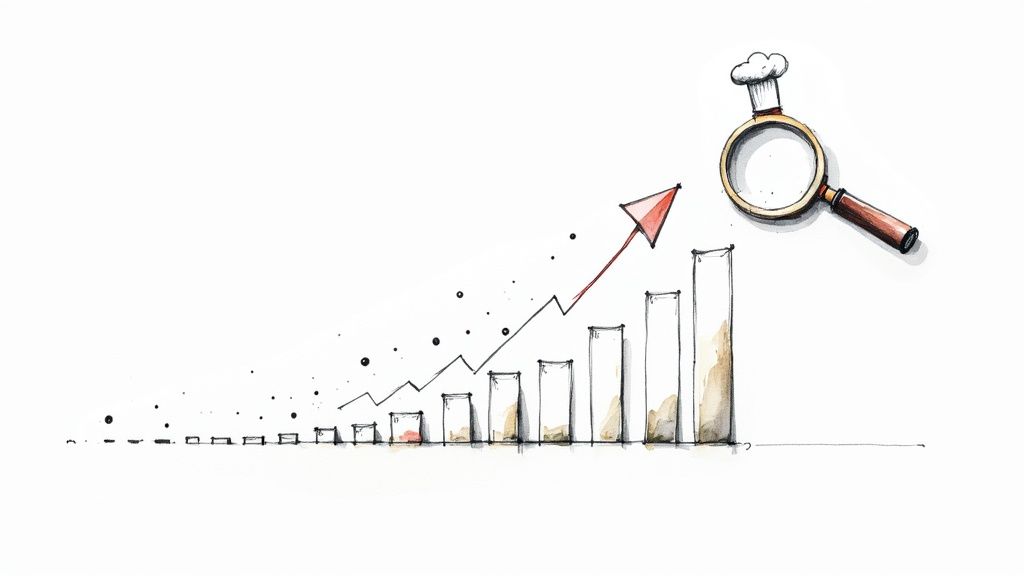
A data-driven marketing agency is an agency that puts hard evidence first. Instead of relying on guesswork or old habits, every single strategic decision is backed by real customer data. This shift leads to smarter campaigns, more predictable results, and a much better return on your marketing dollars.
Think of it this way. A traditional marketer can be like a chef who relies on a secret family recipe. Their experience and gut feelings often produce something good, but the results aren't always consistent.
A data-driven marketing agency, on the other hand, is more like a culinary scientist. They measure every ingredient (data point) and analyze every reaction (customer behavior) to create the perfect dish—your marketing campaign. It’s a methodical approach that takes the guesswork out of the picture.
Instead of just assuming what your audience wants, these agencies dig into the numbers. They collect, analyze, and act on concrete data to figure out what customers need, where trends are heading, and how to build strategies that deliver tangible results. Marketing stops being an art form based on hunches and becomes a reliable growth engine for your business.
This visual captures the difference between marketing based on gut feelings and strategies built on solid evidence.
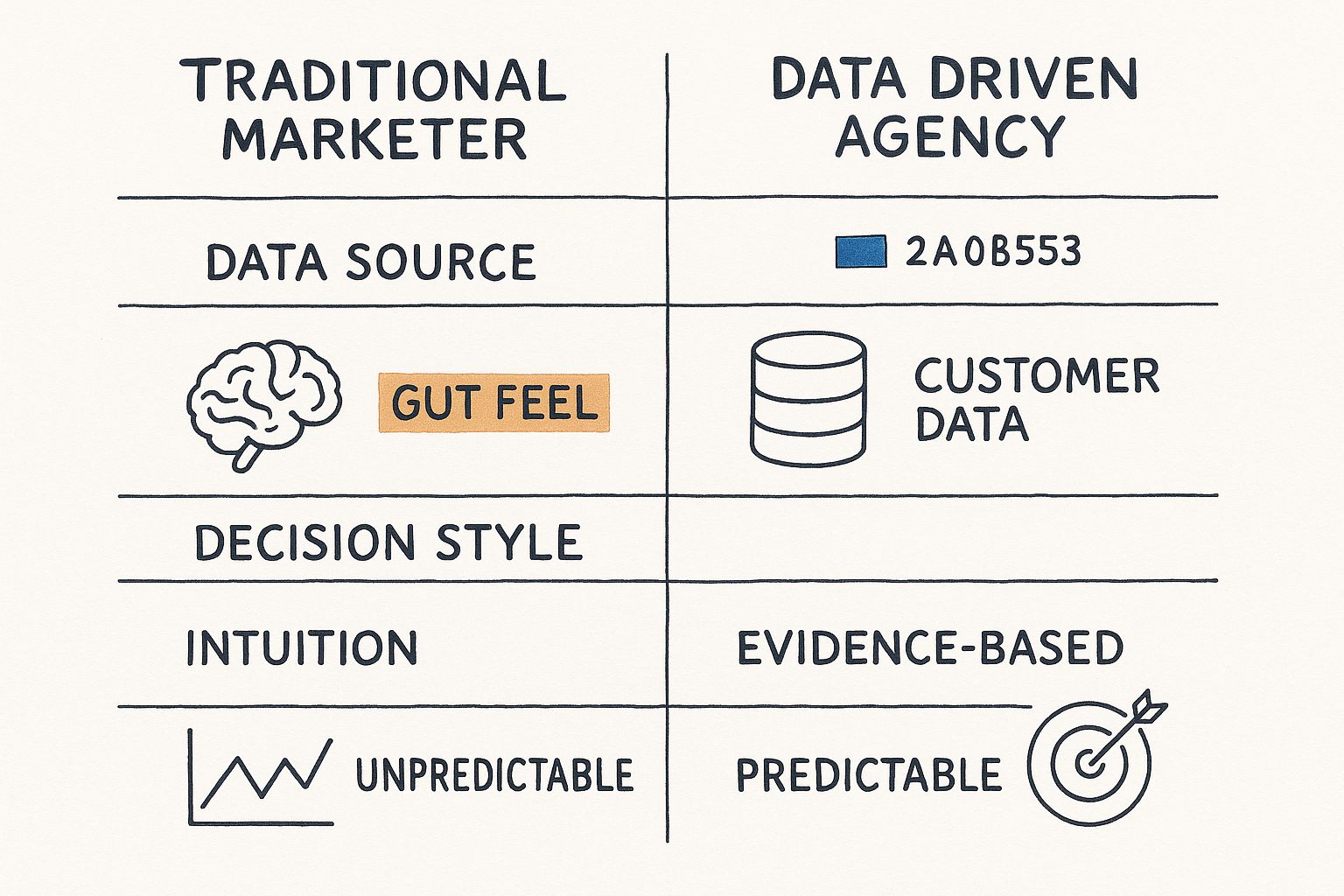
The big takeaway? It's about moving from unpredictable outcomes to predictable growth, all powered by customer data.
A truly data-driven agency is all about a continuous cycle of improvement. This process isn't a one-and-done deal; it's a loop that makes sure your marketing is always in sync with what's actually working.
Here’s what that typically looks like:
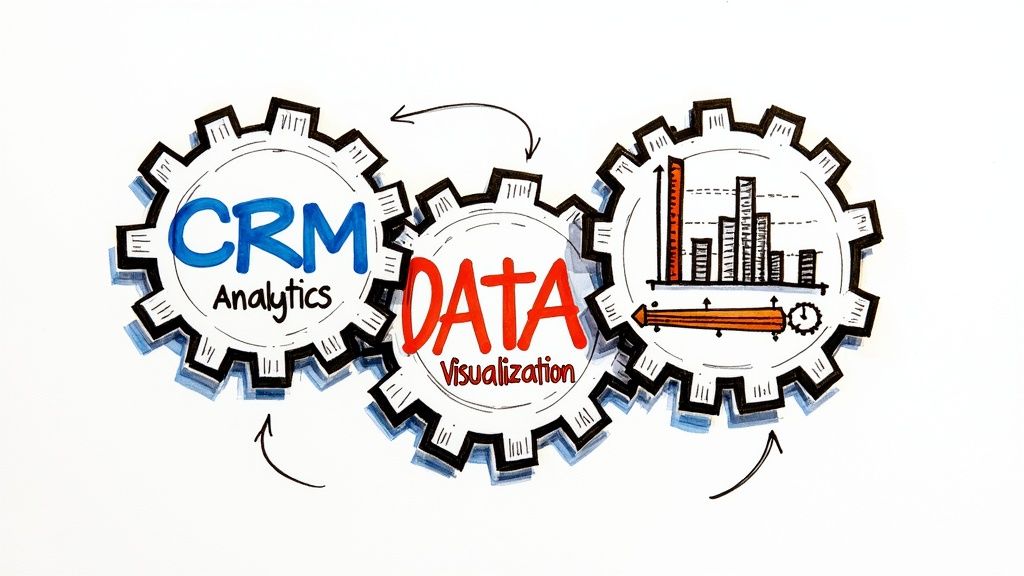
To make truly smart marketing decisions, you need the right tools. Think of it like a skilled mechanic’s workshop—you can't build a high-performance engine with just a hammer. A data-driven agency’s tech stack is their workshop, filled with specialized tools that work together to paint a clear picture of what’s happening with your marketing and why.
At the heart of it all is the Customer Relationship Management (CRM) system. It's the central nervous system for all customer information, neatly organizing everything from contact details and purchase history to every little interaction someone has with your brand. This gives you one clear, unified view of each person.
Then you have analytics platforms, with Google Analytics being a prime example. These are your digital detectives. They track how people behave on your website—what pages they love, how they found you, and where they drop off. These clues are pure gold for making improvements.
Raw numbers don't mean much until you can see the story they're telling. This is where data visualization tools come into play, turning overwhelming spreadsheets into clean charts and dashboards you can understand at a glance. Suddenly, hidden trends and patterns jump right out.
A huge part of a solid data-driven approach is tracking key digital marketing performance metrics. All these tools are designed to help you make sense of the single most valuable asset you have: your first-party data.
First-party data is the information you collect yourself, straight from your audience. It's the most reliable and powerful source for figuring out what your customers actually want.
Ultimately, all this insight flows back into your Content Management System (CMS), the platform that runs your website. A good CMS makes it easy to act on what you've learned. If you want to dive deeper, we have a guide on the top CMS features to look for.
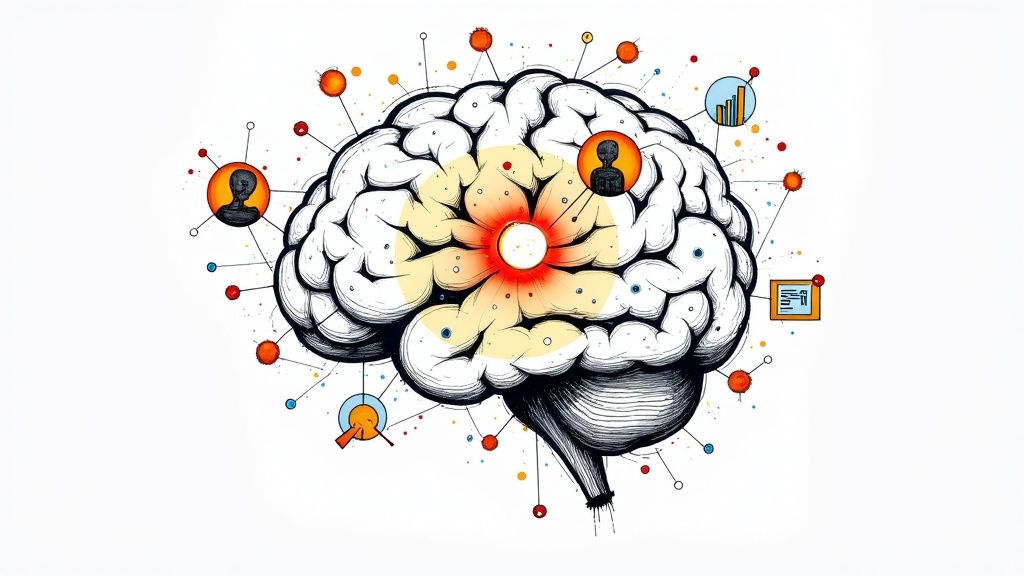
If data is the fuel for your marketing engine, then Artificial Intelligence (AI) is the supercharger. It’s what takes a data driven marketing agency from simply analyzing what already happened to accurately predicting what will happen next.
It's the difference between driving while looking in the rearview mirror and having a smart GPS that shows you the road ahead and reroutes you around traffic.
AI algorithms can churn through mountains of data in minutes—a task that would take a human team weeks. In doing so, they spot subtle patterns in customer behavior that are otherwise invisible. This is where truly powerful personalization comes from. We’re moving beyond basic demographic buckets into a world of hyper-relevant messages tailored to an individual’s real-time actions and needs.
By forecasting trends and automating complex tasks, AI empowers agencies to move from reactive adjustments to proactive strategies. This shift fundamentally changes how campaigns are built, executed, and optimized for maximum impact.
This isn't just a futuristic concept; it's happening now and delivering huge results. The AI in marketing space has ballooned to around $47.32 billion, a staggering jump from just over $12 billion in 2020. That kind of growth doesn't happen unless the technology works. You can dig deeper into these AI marketing statistics on seo.com.
So, how does a modern data driven marketing agency actually use this tech? Here are a few practical examples:
Predictive Analytics: AI can look at past sales and market signals to forecast future demand with surprising accuracy. This helps businesses get ahead of inventory needs and allocate their marketing budget where it will count the most.
Automated Ad Creation: Instead of manually testing a few ad concepts, AI tools can generate and test dozens of variations at once. They'll mix and match headlines, images, and calls-to-action to quickly find the combinations that drive the best results.
AI-Powered Chatbots: Today's chatbots offer instant, 24/7 support, handling common questions and guiding customers. This frees up your human support team to focus on more complex, high-touch issues.
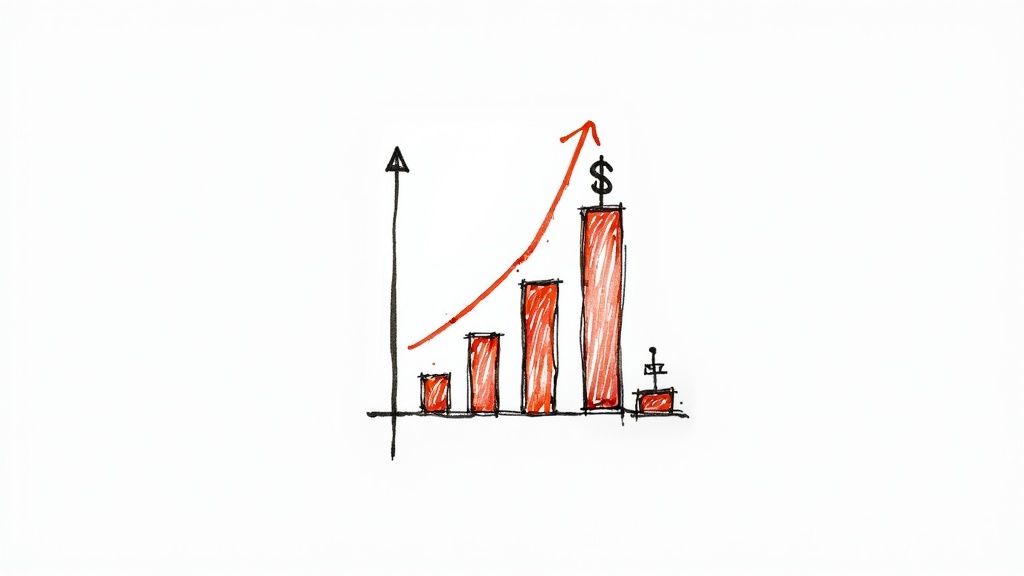
When you boil it all down, data-driven strategies connect your marketing spend directly to real-world business results. Working with an agency that lives and breathes data means every insight is turned into a tangible opportunity for financial growth. It's about focusing on what truly moves the needle.
This approach brings a new level of precision to every campaign. Forget casting a wide net and hoping something sticks. You get laser-focused audience targeting, which means your ad dollars are only spent on people genuinely interested in what you offer. That immediately brings down your Customer Acquisition Cost (CAC).
At the same time, you can create personalized website experiences and messaging based on how real people behave. This builds loyalty and significantly increases your Customer Lifetime Value (CLV) over time.
With a data-first mindset, every dollar has a job, and its performance is tracked relentlessly. This obsession with efficiency is why the entire sector is booming. The global digital marketing agency market generated around $598.58 billion and is expected to hit $1,443.27 billion by 2034. You can dig deeper into these marketing agency growth trends on mycodelesswebsite.com.
The core benefit is simple: when decisions are based on evidence rather than assumptions, you get a significantly higher Return on Investment (ROI). Wasted resources are minimized, and successful tactics are amplified.
By systematically tracking what works and what doesn't, a good agency can constantly refine your strategy. This continuous loop of improvement is what transforms marketing from a cost center into a predictable engine for revenue.
If you're curious about measuring this, check out our guide on how to calculate marketing ROI.
Picking a data-driven marketing agency is a huge decision. You aren't just hiring a vendor to run some ads; you're bringing on a partner who will be instrumental to your growth. A truly great agency does more than just hand you a report—they turn a sea of numbers into a clear roadmap for success.
The right team won't just show you the data; they’ll interpret it. They should be able to walk you through the "why" behind the metrics and tie every campaign result back to your bottom-line business goals. The relationship should feel like they're an extension of your own team, obsessed with turning insights into real-world action.
Recent studies show that 64% of marketing executives are all-in on data-driven strategies, agreeing it's essential for getting high ROI and nailing personalization. You can dig into the specifics by checking out the full report on invoca.com.
To find the right fit, you have to ask the right questions. Forget the slick sales pitch and get down to the nitty-gritty of how they actually work. Their answers will tell you everything you need to know.
Here’s a quick checklist to guide your conversations:
A great tip is to ask for case studies from your industry. Look for a clear story: how they used data to spot a problem and then built a solution that delivered measurable results, like more revenue or a lower cost to acquire customers.
At the end of the day, choosing a data-driven marketing agency is about finding people who can help you understand your customers on a much deeper level. For more on what it takes to find a partner who is just as focused on results as you are, check out our guide on what to look for in a performance based marketing agency.
Jumping into the world of data-driven marketing can bring up a few questions. Here are some straightforward answers to the things people ask us most often.
The biggest difference comes down to how decisions are made. A traditional agency often runs on creative instincts and what's worked in the past. It's an approach that relies heavily on a seasoned "gut feeling," which can be powerful but also unpredictable.
A data-driven marketing agency, on the other hand, lets the numbers do the talking. Every move—from the ad copy we choose to the audience we target—is backed by cold, hard data. We build campaigns on what we know about your customers, track everything with pinpoint accuracy, and constantly tweak our approach based on what’s actually working. This means less guesswork and a much clearer path to a higher ROI.
It’s all about getting a complete 360-degree view of your customer. We use a blend of data sources, but the most important is always first-party data. This is the information you own and collect directly from your audience—think website visitor behavior from Google Analytics or purchase history from your CRM. It’s pure gold because it’s your unique customer truth.
To round out the picture, we might also look at:
The goal is to weave all these threads together to build incredibly detailed customer profiles, create hyper-targeted audience segments, and deliver personalized messages that actually resonate.
While you might see some positive signs pop up quickly, the true power of a data-driven strategy is a long-term game. The first few weeks are all about laying the foundation—setting up tracking, connecting the right tools, and gathering enough initial data to understand where you're starting from.
You'll typically see meaningful, bottom-line results—like a major drop in your customer acquisition cost or a solid jump in conversions—within 3 to 6 months.
This timeframe gives us enough data to move beyond simple tweaks and start making statistically sound optimizations. It's a cycle of continuous improvement. The insights we gain in month one fuel smarter, more effective strategies in month two, creating a snowball effect that builds serious momentum over time.
Ready to stop guessing and start growing with a strategy backed by real numbers? BrandBooster.ai combines expert insights with powerful AI to deliver marketing that performs. See how we guarantee results for your business.